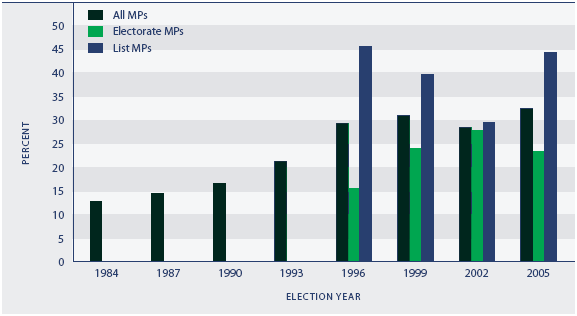Representation of women in government
Definition
The proportion of elected Members of Parliament (MPs) and local
government bodies who are women.
Relevance
The representation of women in government can be seen as an
indicator of political representation more generally. Representative
political institutions engage a wide range of communities in the
political process, draw on the talents and skills of the broadest group
of people, and provide checks and balances on the use of political
power.
Current level and trends
1. General elections
As a result of the 2005 general election, women hold 39 of the
121 seats in Parliament, or 32 percent. This was up from 28 percent in
2002. Under the first-past-the-post electoral system, women’s
representation in Parliament increased from 13 percent in 1984 to 21
percent in 1993, then rose sharply to 29 percent in the first
mixed-member-proportional election held in 1996. There was a further
small rise to 31 percent in 1999, followed by a decline to 28 percent
in 2002.
In 2005, women made up a far higher proportion of list MPs (44
percent) than electorate MPs (23 percent). In the 2002 election, the
female proportions were similar in both categories.
The majority of women elected to Parliament in 2005 were list
MPs (59 percent). The proportion of female electorate MPs increased
from 29 percent in 1996 to 56 percent in 2002, but fell to 41 percent
in 2005.
Figure CP2.1 Women as a proportion of
elected Members of Parliament, 1984–2005

Sources: Electoral Commission (2002) p176;
Electoral Commission (2006)
International comparison
At 32 percent in 2005, the percentage of women in New
Zealand's Parliament is considerably higher than the OECD median of 22
percent in recent years.70 New
Zealand ranks 9th equal out of 30 OECD nations. Sweden has the
highest proportion of women MPs with 47 percent, followed by Finland
(42 percent), Norway (38 percent), Denmark and the Netherlands (each 37
percent), and Spain (36 percent). Australia (25 percent), Canada (21
percent), the United Kingdom (20 percent) and the United States (16
percent) all have much lower female representation in national
government than New Zealand .
Current level and trends
2. Local authority elections
In the 2004 local government elections, 566 women were elected
to local authorities.71 This
represented 30 percent of elected members. The proportion of women
elected increased from 25 percent in 1989 to 31 percent in 1998 and
remained at around that level in the two subsequent elections. In the
1980s, women were more highly represented in local government than in
national government, but this was reversed in the 2005 general election.
Female candidates were more likely than male candidates to be
elected in each election year from 1989 to 1998, but this was reversed
in 2001, when 41 percent of women candidates were elected, compared
with 44 percent of men. In 2004, 48 percent of female candidates were
elected, compared with 49 percent of male candidates.
In 2004, women’s representation was highest on district health
boards (43 percent), followed by city councils (34 percent) and
community boards (32 percent). Between 2001 and 2004, the share of
women remained about the same in all local authorities except city
councils, where it fell from 39 to 34 percent.
The number of women elected to city council mayoral positions
has remained steady at four (out of 16) for most election years since
1989. In contrast, the number of women mayors in district councils
increased rapidly from six (out of 59) in 1989 to 15 in 1998, fell
sharply to eight in 2001 and rose slightly to 10 in 2004.
Table CP2.1 Proportion (%) of members who
were women, by type of local body, 1989–2004
| |
1989 |
1992 |
1995 |
1998 |
2001 |
2004 |
| Regional councils |
22 |
25 |
29 |
28 |
26 |
25 |
| District health boards |
– |
– |
– |
– |
44 |
42 |
| City councils |
35 |
35 |
33 |
36 |
39 |
34 |
| District councils |
19 |
23 |
26 |
27 |
26 |
26 |
| Community boards |
29 |
32 |
33 |
35 |
31 |
32 |
| Licensing and land trusts |
– |
– |
– |
– |
– |
30 |
Source: Department of Internal Affairs (2006)
Table 6.4
Note: District councils 2001 revised by Department of Internal Affairs
Table CP2.2 Women mayors, 1989–2004
| |
1989 |
1992 |
1995 |
1998 |
2001 |
2004 |
| City councils |
4/14 |
4/15 |
3/15 |
4/15 |
4/15 |
4/16 |
| District councils |
6/59 |
9/59 |
12/59 |
15/59 |
8/58 (1) |
10/58 (2) |
Source: Department of Internal Affairs (2006)
Table 6.5
Notes: (1) There was no election in Rodney District in 2001 (2)
Tauranga became a city council in 2004
|

